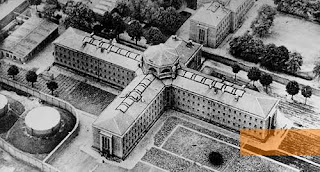Executions in Berlin's Plötzensee prison–world history and facts
Executions in Berlin's Plötzensee prison.
Plötzensee prison in Berlin was designed by architect, Ludwig Alexander Herrmann, and was constructed between 1869 and 1879 to serve as the new state prison. It occupied a plot of 62 acres with a six meter high perimeter wall.
Within the walls were five three story prison buildings which were originally designed to hold 1,400 prisoners. These buildings, together with the workshops, other smaller buildings and a church, were separated by open courtyards creating a totally self-contained environment for the inmates. It can still be visited and there is a memorial centre to those who died there.
In the years 1928 to 1932, the number of executions in the whole of Germany had dropped to two or three a year but with the rise of the National Socialist party in 1933, there was a sudden increase in the application of the death penalty.
Before 1933, only murder and high treason were capital crimes and in Berlin, beheading (with the axe) was the only lawful method of execution. (Other states used beheading with the axe or the guillotine).
One of the last executions by the axe in Plötzensee were those of the Baroness Benita von Falkenhayn and her friend Renate von Natzner , who were convicted of spying and beheaded by the executioner, Carl Gröpler, on the 18th of February 1935.
In all, 45 people were beheaded in the prison courtyard between 1933 and 1936. Only 36 had been beheaded here in the period 1890–1932, all for murder.
There were 64 executions in Germany in 1933, 79 in 1934, 94 in 1935 and 68 in 1936.
When Hitler came to total power, he decided that criminals and those who opposed his regime should suffer death by either guillotining or from 1942, hanging, and he ordered the construction of 20 guillotines.
Hitler also greatly increased the list of capital crimes. Between 1933 and 1944, a total of 13,405 death sentences were passed. Of these, 11,881 were carried out. In 1940 alone, some 900 German civilians were put to death. In 1941, the minimum age for execution was reduced to just 14 years.
The execution rate had risen to over 5,000 by 1943. Between 1943 and 1945, the People's Courts sentenced around 7,000 people to death. In the first few months of 1945, some 800 people were executed, over 400 of them being German citizens.
Condemned prisoners were kept in a large cell block building (House III) directly adjacent to the execution building. They spent their final hours shackled in special cells on the ground floor, which was known as the ”house of the dead,” before being led across a small courtyard to the execution chamber which was located in a separate two roomed brick building.
Plötzensee's guillotine was delivered on the 17th of February 1937 from Bruchsal prison in Baden. In late 1942, a steel gallows beam was erected in the existing execution chamber, and originally had five, later eight hooks, for attachment of nooses. The two execution areas were separated by curtains.
Between 1933 and 1945, some 2,891 people were decapitated or hanged in this building. Many of them were opponents of Hitler's National Socialist government. They had been sentenced to death by the People's Courts, having been found guilty of various offences against the regime.
Some of them had belonged to Communist resistance groups, others to the Harnack/Schulze-Boysen Organization (the Red Orchestra), and still others to the Kreisau Circle. On the 20th of July 1944, an attempt was made on Hitler's life by a group of army officers led by Colonel Claus von Stauffenberg.
The attempt failed, and between the 8th of August 1944 and the 9th of April 1945, a total of 90 people were executed in Plötzensee for their parts in the conspiracy.
Initially Roettger, the executioner, normally came twice a week and carried out his work in the early evenings. Guillotinings could be carried out at three minute intervals. Hangings were notably cruel, the prisoner was led in with their hands tied behind them and made to get up onto the two step step-up, the executioner following them and placing the thin cord slip knot around their neck.
They were not hooded or blindfolded. The executioner got down and simply pulled the step-up from under them leaving them suspended with little or no drop. Second and subsequent prisoners had to witness the struggles of the first before it was their turn.
On the night of the 7th–8th September 1943, 186 prisoners were hanged in groups of 8 at a time to prevent their escape from the prison following heavy damage by an Allied bombing raid in which the guillotine was destroyed. A further 60 were to be hanged over the next few nights.



.jpg)

.jpeg)






Comments
Post a Comment